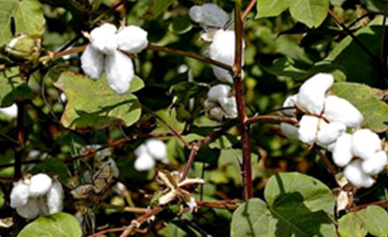Cotton

The history of introduction into India of the new world cottons dates back to the 18th century AD. By the last decade of the 20th century, India had gained a pride of place in the global cotton statistics with the largest cropped area and production of around 5,300 million kgs in 2021-22, growing the most diverse cultivars in terms of botanical species and composition, producing the widest range of cotton fibre and supporting the largest agro-based national industry of the country. India ranks as the 2nd largest producer of cotton in the world.
In the late 18th and 19th century, the fortunes of Indian cotton seem to have been linked with the adequacy or otherwise of cotton exports to England from America. In an attempt to develop an alternative source of supply (apart from America), the East India Company initiated trials with exotic cottons (new world cotton varieties) introduced into India.
The first attempt was made in 1790 AD to grow Bourbon (G. hirsutumrace punctatum) variety introduced from Malta and Mauritius in the Bombay and Madras Provinces. The initial trials proved unsatisfactory. In 1840 AD, trials with exotic American cotton were carried out in Gujarat, the Deccan, and the Konkan. New Orleans seed (G. hirsutumrace larifolium) was grown in 1842 AD in Hubi taluk of Karnataka and by 1861-62 was grown on 72313 ha.
After the reorganization of the Madras Department of Agriculture in 1905, American, Peruvian, Egyptian, and Sea Island varieties were experimented with, but without success. The most significant development for the future success and spread of American cotton in India was the introduction of a cotton variety originally found suitable in Indo-China.
Since launch of “Technology Mission on Cotton” by Government of India in February 2000 significant achievements have been made in increasing yield and production through development of high yielding varieties, appropriate transfer of technology, better farm management practices etc. All these developments have resulted into a turnaround in cotton production in the country since last few years.
Cotton – All India Area and Production
|
|
2018-19 |
2019-20 | 2020-21 | 2021-22 | 2022-23 (P)* |
| Area (Million Hectares) |
12.6 | 13.5 | 13.3 | 11.9 | 12.9 |
| Production (Million Bales)^ |
28.0 | 36.1 | 35.2 | 31.2 | 33.66 |
Source: Directorate of Economics & Statistics, Department of Agriculture and Farmers Welfare.
^ Bales of 170 Kgs, (P) – Provisional, * 2nd Advance Estimates of Production of Oilseeds & Commercial Crops for 2023-24
Cotton Exports From India
|
|
2019-20 |
2020-21 | 2021-22 |
2022-23 |
2023-24* |
|
Value |
40,714.81 | 46,662.66 | 80,434.53 | 45,352.18 | 44,542.91 |
*2023-2024 (April – January)
Source: Department of Commerce, Ministry of Commerce and Industry, Govt. of India
https://tradestat.commerce.gov.in
Use of Bt. Cotton Hybrid Seeds
Bt Cotton is the only transgenic crop approved in the country for commercial cultivation. The Genetic Engineering Appraisal Committee (GEAC) of the Ministry of Environment, Forests and Climate Change is the nodal agency for grant of permission for environmental release of Bt. Cotton hybrids under the Environment Protection Act, 1986 in the country.
At present, about 1128 Bt. Cotton hybrid seeds are available for cultivation in the country. These Bt. Cotton hybrids are grown in ten (10) States i.e., Gujarat, Madhya Pradesh, Maharashtra, Andhra Pradesh, Telangana, Karnataka, Tamil Nadu, Haryana, Punjab and Rajasthan.
